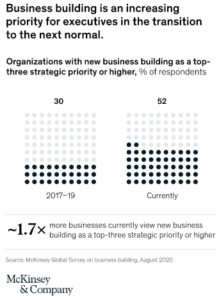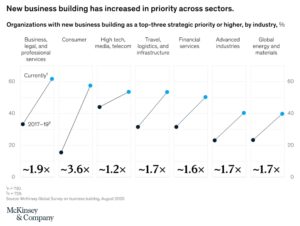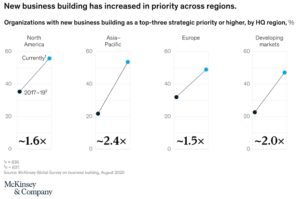Business building is the top priority for organic growth at companies during the COVID-19 pandemic, and incumbents are launching new businesses with ever greater frequency, according to our new global survey. 1 The findings suggest that companies that prioritize business building tend to grow faster than their peers, respond with greater resilience to volatility and economic shocks, and, as they gain experience building businesses, see more success from it. But not all companies succeed: only 24 percent of new businesses launched in the past ten years are viable large-scale enterprises today.
To shed light on the differences between outperformers and also-rans, our survey included more than 800 company executives across a range of industries, sectors, and geographies. So far as we know, this was the first at-scale research to explore corporate business building. The survey revealed that an impressive 52 percent of executives consider business building a top-three (or higher) priority for growth. We also found that a small set of companies enjoy success rates two times higher than those of high-potential start-ups (24 percent versus 8, respectively). 2 The experience of these companies clarifies the winning approach to launching and scaling new businesses. As more companies adopt these successful practices, a new wave of innovation could arise from not just entrepreneurial efforts but also intrapreneurial ones. That would boost organic growth and improve the prospects of companies looking to jump into the top tier of performance.
The new priority for organic growth.
Even before the pandemic, our own experience indicated that business building had become more important for incumbent companies looking to use innovative business models, products, and services to meet the threats and opportunities of a digitizing world. The COVID-19 crisis has accelerated and intensified that trend. In many industries, the pandemic has rewritten rules and upended assumptions, all while diminishing—or threatening to diminish—existing revenue streams. Replacing lost revenues, of course, requires finding new forms of growth. And while M&A remains an essential part of the growth playbook, P/E multiples remain high, and acquisitions can be expensive. Moreover, organic growth often creates greater excess returns to shareholders than dealmaking does, even during more normal times.
We studied four different approaches to organic growth and found that business building was the most effective among them. 3 Some 74 percent of companies that chose business building as their main strategy grew at rates above the average of their industries. Only 58 percent of the companies that prioritized different strategies did. No wonder so many executives ranked business building as a top-three priority for 2020 (Exhibit 1). And these companies are putting their money where their priorities are, allocating, on average, one-third of their organic-growth capital to business building—more than twice as much as the laggards do. The shift to business building isn’t confined to a few sectors or regions. In all those we surveyed, companies give business building pride of place on the corporate agenda (Exhibits 2 and 3).
More: https://www.mckinsey.com/business-functions/
About the authors: Shaun Collins is a consultant in McKinsey’s Boston office, where Upasana Unni is an associate partner; Ralf Dreischmeier is a senior partner in the London office; and Ari Libarikian is a senior partner in the New York office. The authors wish to thank Paige Frank and Anton Kärrman for their contributions to this article.


